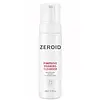What's inside
What's inside
 Key Ingredients
Key Ingredients

 Benefits
Benefits

 Concerns
Concerns

 Ingredients Side-by-side
Ingredients Side-by-side

Water
Skin ConditioningGlycerin
HumectantDisodium Cocoyl Glutamate
CleansingLauryl Hydroxysultaine
CleansingCoco-Glucoside
CleansingPropanediol
SolventSodium Methyl Cocoyl Taurate
Cleansing1,2-Hexanediol
Skin ConditioningSalicylic Acid
MaskingSodium Chloride
MaskingHydroxyacetophenone
AntioxidantCitric Acid
BufferingO-Cymen-5-Ol
AntimicrobialSodium Phytate
Sodium Lactate
BufferingSodium Gluconate
Skin ConditioningZinc PCA
HumectantHydrolyzed Hyaluronic Acid
HumectantMyristoyl/Palmitoyl Oxostearamide/Arachamide Mea
Skin ConditioningWater, Glycerin, Disodium Cocoyl Glutamate, Lauryl Hydroxysultaine, Coco-Glucoside, Propanediol, Sodium Methyl Cocoyl Taurate, 1,2-Hexanediol, Salicylic Acid, Sodium Chloride, Hydroxyacetophenone, Citric Acid, O-Cymen-5-Ol, Sodium Phytate, Sodium Lactate, Sodium Gluconate, Zinc PCA, Hydrolyzed Hyaluronic Acid, Myristoyl/Palmitoyl Oxostearamide/Arachamide Mea
Water
Skin ConditioningGlycerin
HumectantLauric Acid
CleansingPalmitic Acid
EmollientStearic Acid
CleansingMyristic Acid
CleansingPotassium Hydroxide
BufferingCocamidopropyl Betaine
CleansingPEG-100 Stearate
Glyceryl Stearate
EmollientBeeswax
Emulsion StabilisingButylene Glycol
HumectantPrunus Persica Fruit Extract
AbrasiveSodium Hyaluronate
HumectantSolanum Lycopersicum Fruit Extract
AntioxidantPunica Granatum Fruit Extract
AntioxidantHippophae Rhamnoides Extract
MaskingBeta Vulgaris Root Extract
Skin ConditioningSorbitan Olivate
EmulsifyingSodium Chloride
MaskingArachidic Acid
CleansingCapric Acid
CleansingOleic Acid
EmollientCaprylyl Glycol
EmollientDisodium EDTA
Sodium Benzoate
Masking1,2-Hexanediol
Skin ConditioningEthylhexylglycerin
Skin ConditioningParfum
MaskingLinalool
PerfumingBenzyl Benzoate
AntimicrobialLimonene
PerfumingWater, Glycerin, Lauric Acid, Palmitic Acid, Stearic Acid, Myristic Acid, Potassium Hydroxide, Cocamidopropyl Betaine, PEG-100 Stearate, Glyceryl Stearate, Beeswax, Butylene Glycol, Prunus Persica Fruit Extract, Sodium Hyaluronate, Solanum Lycopersicum Fruit Extract, Punica Granatum Fruit Extract, Hippophae Rhamnoides Extract, Beta Vulgaris Root Extract, Sorbitan Olivate, Sodium Chloride, Arachidic Acid, Capric Acid, Oleic Acid, Caprylyl Glycol, Disodium EDTA, Sodium Benzoate, 1,2-Hexanediol, Ethylhexylglycerin, Parfum, Linalool, Benzyl Benzoate, Limonene
Ingredients Explained
These ingredients are found in both products.
Ingredients higher up in an ingredient list are typically present in a larger amount.
1,2-Hexanediol is a synthetic liquid and another multi-functional powerhouse.
It is a:
- Humectant, drawing moisture into the skin
- Emollient, helping to soften skin
- Solvent, dispersing and stabilizing formulas
- Preservative booster, enhancing the antimicrobial activity of other preservatives
Glycerin is already naturally found in your skin. It helps moisturize and protect your skin.
A study from 2016 found glycerin to be more effective as a humectant than AHAs and hyaluronic acid.
As a humectant, it helps the skin stay hydrated by pulling moisture to your skin. The low molecular weight of glycerin allows it to pull moisture into the deeper layers of your skin.
Hydrated skin improves your skin barrier; Your skin barrier helps protect against irritants and bacteria.
Glycerin has also been found to have antimicrobial and antiviral properties. Due to these properties, glycerin is often used in wound and burn treatments.
In cosmetics, glycerin is usually derived from plants such as soybean or palm. However, it can also be sourced from animals, such as tallow or animal fat.
This ingredient is organic, colorless, odorless, and non-toxic.
Glycerin is the name for this ingredient in American English. British English uses Glycerol/Glycerine.
Learn more about GlycerinChances are, you eat sodium chloride every day. Sodium Chloride is also known as table salt.
This ingredient has many purposes in skincare: thickener, emulsifier, and exfoliator.
You'll most likely find this ingredient in cleansers where it is used to create a gel-like texture. As an emulsifier, it also prevents ingredients from separating.
There is much debate on whether this ingredient is comedogenic. The short answer - comedogenic ratings don't tell the whole story. Learn more about comegodenic ratings here.
The concensus about this ingredient causing acne seems to be divided. Research is needed to understand if this ingredient does cause acne.
Scrubs may use salt as the primary exfoliating ingredient.
Learn more about Sodium ChlorideWater. It's the most common cosmetic ingredient of all. You'll usually see it at the top of ingredient lists, meaning that it makes up the largest part of the product.
So why is it so popular? Water most often acts as a solvent - this means that it helps dissolve other ingredients into the formulation.
You'll also recognize water as that liquid we all need to stay alive. If you see this, drink a glass of water. Stay hydrated!
Learn more about Water